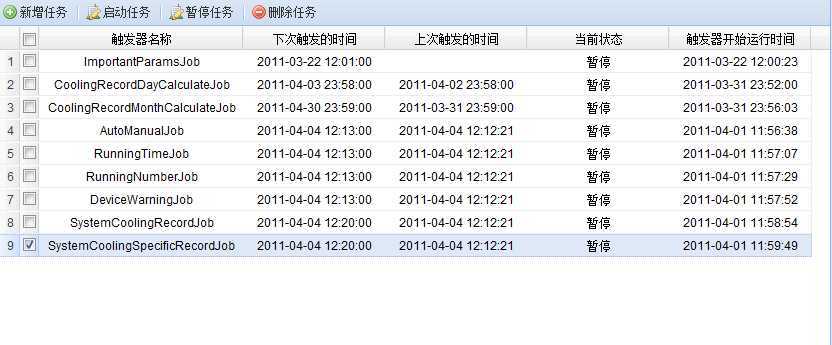标签:style blog http io ar color os 使用 sp
先来几张实现图

任务管理页

新建任务管理.目前实现叫简单的需求...若各位同学要实现复杂的设计...quartz都有提供强大的支持.小弟目前的需求做到这已经够用了.
接下来.我们如何实现quartz的热部署编码呢?
小弟是利用spring整合quzrtz实现的.但是会产生两个小问题.
我们先看看quartz如何与spring整合
<bean name="quartzScheduler" class="org.springframework.scheduling.quartz.SchedulerFactoryBean"> <property name="dataSource" ref="dataSource"/> <property name="applicationContextSchedulerContextKey" value="applicationContextKey"/> <property name="configLocation" value="classpath:quartz.properties"/><!-- 这个是必须的,QuartzScheduler 延时启动,应用启动完后 QuartzScheduler 再启动 --> <property name="startupDelay" value="30"/><!-- 这个是可选,QuartzScheduler 启动时更新己存在的Job,这样就不用每次修改targetObject后删除qrtz_job_details表对应记录了 --> <property name="overwriteExistingJobs" value="true"/> <property name="jobDetails" > <list> <ref bean="xxxJobDetail"/> </list> </property> </bean>
首先.我们需要添加一个数据源给quzrtz.允许其序列化JobDetail到数据库.之后有注释.呵呵.我就不必多说了.
<bean id="xxxJobDetail" class="frameworkx.springframework.scheduling.quartz.MethodInvokingJobDetailFactoryBean">
<!--shouldRecover属性为true,则当Quartz服务被中止后,再次启动任务时会尝试恢复执行之前未完成的所有任务-->
<!--<property name="shouldRecover" value="true"/>-->
<!-- 标识job是持久的,删除触发器的时候不被删除 -->
<property name="durable" value="true"/>
<property name="targetObject" ref="xxxxJob"/>
<!-- 此处是需要执行的任务的方法 -->
<property name="targetMethod" value="executeJob"/>
</bean>
凡是使用过quartz跟spring整合的同学会发现.为什么class的命名空间不是org.springframework.scheduling.quartz.MethodInvokingJobDetailFactoryBean呢?
因为spring技术小组的class会报NotSerializableException.且功能不强shouldRecover,durable这些基础属性不提供...大概spring的MethodInvokingJobDetailFactoryBean根本不支持JobDetail的序列化...想详细了解原因.可以看spring的源码.目前小弟使用的spring3,spring小组依然没解决这问题,应该说还不支持JobDetail序列化.但国外牛人们已经帮我们解决好了.详细见下连接
http://jira.springframework.org/browse/SPR-3797
好了.接下来我们需要配置quzrtz的properties(放到classpath下.quzrtz就能找到)
org.quartz.scheduler.instanceName = DefaultQuartzScheduler org.quartz.scheduler.rmi.export = false org.quartz.scheduler.rmi.proxy = false org.quartz.scheduler.wrapJobExecutionInUserTransaction = false org.quartz.threadPool.class = org.quartz.simpl.SimpleThreadPool org.quartz.threadPool.threadCount = 10 org.quartz.threadPool.threadPriority = 5 org.quartz.threadPool.threadsInheritContextClassLoaderOfInitializingThread = true org.quartz.jobStore.misfireThreshold = 60000 #org.quartz.jobStore.class = org.quartz.simpl.RAMJobStore org.quartz.jobStore.class = org.quartz.impl.jdbcjobstore.JobStoreTX #org.quartz.jobStore.driverDelegateClass=org.quartz.impl.jdbcjobstore.HSQLDBDelegate org.quartz.jobStore.driverDelegateClass=org.quartz.impl.jdbcjobstore.StdJDBCDelegate #org.quartz.jobStore.useProperties = true org.quartz.jobStore.tablePrefix = QRTZ_ org.quartz.jobStore.isClustered = false org.quartz.jobStore.maxMisfiresToHandleAtATime=1
我们这次是选择org.quartz.jobStore.class = org.quartz.impl.jdbcjobstore.JobStoreTX
而不是默认的org.quartz.jobStore.class = org.quartz.simpl.RAMJobStore简单存储在内存中.
接来下,我们需要一个quartz的scheduler管理类.
protected final Log log = LogFactory.getLog(getClass()); private Scheduler scheduler; private QuartzDao quartzDao; private static final Logger logger = LoggerFactory.getLogger(SchedulerServiceImpl.class); public void setScheduler(Scheduler scheduler) { this.scheduler = scheduler; } public void setQuartzDao(QuartzDao quartzDao) { this.quartzDao = quartzDao; } /** * 根据job的名称获取job,进而添加到trigger * @param name * @param jobName * @param cronExpression * @param group * @throws SchedulerException */ public void schedule(String name, String jobName, String cronExpression,String group) throws SchedulerException { if (name == null || name.trim().equals("")) { name = UUID.randomUUID().toString(); } try { JobDetail jobDetail = scheduler.getJobDetail(jobName, group); if(jobDetail != null) { scheduler.addJob(jobDetail, true); CronTrigger cronTrigger = new CronTrigger(name, group, jobDetail.getName(), Scheduler.DEFAULT_GROUP); cronTrigger.setCronExpression(new CronExpression(cronExpression)); scheduler.scheduleJob(cronTrigger); scheduler.rescheduleJob(cronTrigger.getName(), cronTrigger.getGroup(), cronTrigger); }else log.error("无法找到对应的job.所以无法建立trigger"); } catch (SchedulerException e) { log.error(e.getMessage()); throw new SchedulerException(); } catch (ParseException e) { log.error(e.getMessage()); } } public List<Map<String, Object>> getQrtzTriggers(){ return quartzDao.getQrtzTriggers(); } public void pauseTrigger(String triggerName,String group) throws SchedulerException{ try { scheduler.pauseTrigger(triggerName, group);//停止触发器 } catch (SchedulerException e) { log.error(e.getMessage()); throw new SchedulerException(); } } public void resumeTrigger(String triggerName,String group) throws SchedulerException{ try { scheduler.resumeTrigger(triggerName, group);//重启触发器 } catch (SchedulerException e) { log.error(e.getMessage()); throw new SchedulerException(); } } public boolean removeTrigdger(String triggerName,String group) throws SchedulerException{ try { scheduler.pauseTrigger(triggerName, group);//停止触发器 return scheduler.unscheduleJob(triggerName, group);//移除触发器 } catch (SchedulerException e) { log.error(e.getMessage()); throw new SchedulerException(); } } public String[] getJobNames(String group) throws SchedulerException { String[] jobNames = null; try { jobNames = scheduler.getJobNames(group); } catch (SchedulerException e) { log.error(e.getMessage()); throw new SchedulerException(); } return jobNames; }
但前只是简单实现通过cornexpression.若有复杂配置trigger规则的.或需要对trigger添加calendar...可以自己进行扩展.
一下是quzrtzDao的实现
private DataSource dataSource; public void setDataSource(DataSource dataSource) { this.dataSource = dataSource; } public List<Map<String, Object>> getQrtzTriggers() { List<Map<String, Object>> results = getJdbcTemplate().queryForList("select * from QRTZ_TRIGGERS order by start_time"); long val = 0; String temp = null; for (Map<String, Object> map : results) { temp = MapUtils.getString(map, "trigger_name"); if(StringUtils.indexOf(temp, "#") != -1){ map.put("display_name", StringUtils.substringBefore(temp, "#")); }else{ map.put("display_name", temp); } val = MapUtils.getLongValue(map, "next_fire_time"); if (val > 0) { map.put("next_fire_time", DateFormatUtils.format(val, "yyyy-MM-dd HH:mm:ss")); } val = MapUtils.getLongValue(map, "prev_fire_time"); if (val > 0) { map.put("prev_fire_time", DateFormatUtils.format(val, "yyyy-MM-dd HH:mm:ss")); } val = MapUtils.getLongValue(map, "start_time"); if (val > 0) { map.put("start_time", DateFormatUtils.format(val, "yyyy-MM-dd HH:mm:ss")); } val = MapUtils.getLongValue(map, "end_time"); if (val > 0) { map.put("end_time", DateFormatUtils.format(val, "yyyy-MM-dd HH:mm:ss")); } map.put("statu",status.get(MapUtils.getString(map, "trigger_state"))); } return results; } public static final Map<String,String> status = new HashMap<String,String>(); static{ status.put("ACQUIRED", "运行"); status.put("PAUSED", "暂停"); status.put("WAITING", "等待"); } private JdbcTemplate getJdbcTemplate() { return new JdbcTemplate(this.dataSource); }
同学们可以根据自己的风格,修改一下其代码.
此时我们就可以创建一个简单的quzrtz的热部署管理.
我之前讲过会有两个问题.第二个问题是什么呢?还记得讲过我们需要讲jobDetail序列化到数据库吗?因为我们使用了spring 系统中的manager类通过spring的IOC依赖注入.那我们的跟quartz相关的manager都需要声明实现Serializable序列化接口.
此时我们可以想到用ContextLoader.getCurrentWebApplicationContext()把相应的manage通过bean id get出来.
public class SpringBeanProvide implements Serializable/*, ApplicationContextAware*/{ /** * */ private static final long serialVersionUID = 8430477279431126488L; private ApplicationContext context; @SuppressWarnings("unchecked") public <T> T getBean(Class<T> clazz, String beanName){ context = ContextLoader.getCurrentWebApplicationContext(); return (T)context.getBean(beanName); } public ServletContext getServletContext() { WebApplicationContext webContext = ContextLoader.getCurrentWebApplicationContext(); return webContext.getServletContext(); } /*@Autowired public void setApplicationContext(ApplicationContext context) throws BeansException { this.context = context; }*/ }
我们看看ContextLoader.getCurrentWebApplicationContext()的源码
/** * Obtain the Spring root web application context for the current thread * (i.e. for the current thread‘s context ClassLoader, which needs to be * the web application‘s ClassLoader). * @return the current root web application context, or <code>null</code> * if none found * @see org.springframework.web.context.support.SpringBeanAutowiringSupport */ public static WebApplicationContext getCurrentWebApplicationContext() { ClassLoader ccl = Thread.currentThread().getContextClassLoader(); if (ccl != null) { WebApplicationContext ccpt = currentContextPerThread.get(ccl); if (ccpt != null) { return ccpt; } } return currentContext; }
currentContextPerThread是一个final的ConcurrentHashMap.也是IOC容器存储bean的一个hash表.
到底什么时候才把ccl设置到currentContextPerThread中呢?
我们往上看源码
try { // Determine parent for root web application context, if any. ApplicationContext parent = loadParentContext(servletContext); // Store context in local instance variable, to guarantee that // it is available on ServletContext shutdown. this.context = createWebApplicationContext(servletContext, parent); servletContext.setAttribute(WebApplicationContext.ROOT_WEB_APPLICATION_CONTEXT_ATTRIBUTE, this.context); ClassLoader ccl = Thread.currentThread().getContextClassLoader(); if (ccl == ContextLoader.class.getClassLoader()) { currentContext = this.context; } else if (ccl != null) { currentContextPerThread.put(ccl, this.context); }
其中...currentContextPerThread.put(ccl, this.context);是在ApplicationContext parent = loadParentContext(servletContext);之下.
ContextLoader.getCurrentWebApplicationContext()只能在容器完全初始化后才能使用..这对于单元测试时...ccpt返回出来的是一个null...
这就是我为什么会在SpringBeanProvide出现注释了ApplicationContextAware的原因...因为本人有点懒...哈哈..没重新整理一份spring的bean xml作为单元测试使用...所以...在单元测试时...改一下注释...就去跑了..呵呵...此时...我们已经可以使用quzrtz的热部署.不必重启服务器就可以对任务进行管理了.
以上的实现.参考了javaeye中的部分文章.
本文转自:http://www.cnblogs.com/pigwing/archive/2011/04/04/2005158.html
标签:style blog http io ar color os 使用 sp
原文地址:http://www.cnblogs.com/dreammyle/p/4122070.html